本章将和大家分享ASP.NET Core中的Web API。
一、RESTful架构风格
REST(Representational State Transfer)表现层的状态转化,是一个接口的设计风格。是Web服务的一种新的架构风格(一种思想)。
资源:万物看成资源。
使用POST,DELETE,PUT和GET四种请求方式分别对指定的URL资源进行增删改查操作,RESTful是通过URI实现对资源的管理及访问,具有扩展性强、结构清晰的特点。
URI:统一资源标识符,资源对应的唯一地址。
统一接口:CRUD增删改查,跟HTTP Method对应。
REST架构的主要原则:
1、对网络上所有的资源都有一个资源标志符。
2、对资源的操作不会改变标识符。
3、同一资源有多种表现形式(
4、所有操作都是无状态的(Stateless)。
符合上述REST原则的架构方式称为RESTful
无状态:
基于Http协议,(登陆系统--查询工资--计算税收,有状态)
无状态的直接一个地址,就能拿到工资,就能得到税收
关于RESTful更多资料可参考博文:https://blog.csdn.net/x541211190/article/details/81141459
二、Web API
WebApi:RESTful架构风格,http协议 无状态 标准化操作 更轻量级,尤其是json,适合移动端。
Web API和MVC差别:
专人做专事,它们的管道模式是不一样的。
Web API中是没有生成页面这套东西的,它不需要去找视图那些东西,它也不存在去弄session之类的,Web API是专门提供数据的,比起MVC来讲Web API更轻量级。
Web API严格遵守了RESTful架构风格。
接下来我们来看下代码部分:
1、Web API项目创建(使用VS2019)
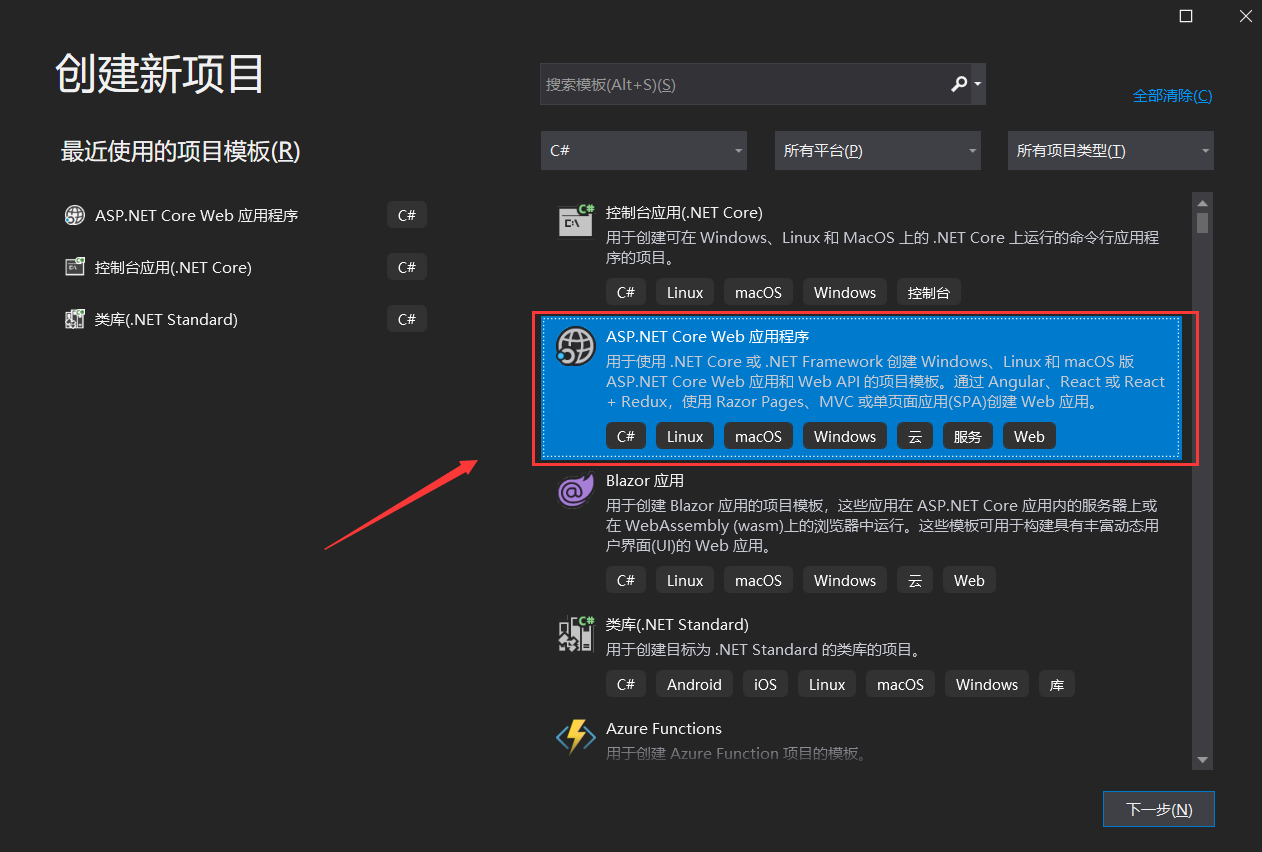
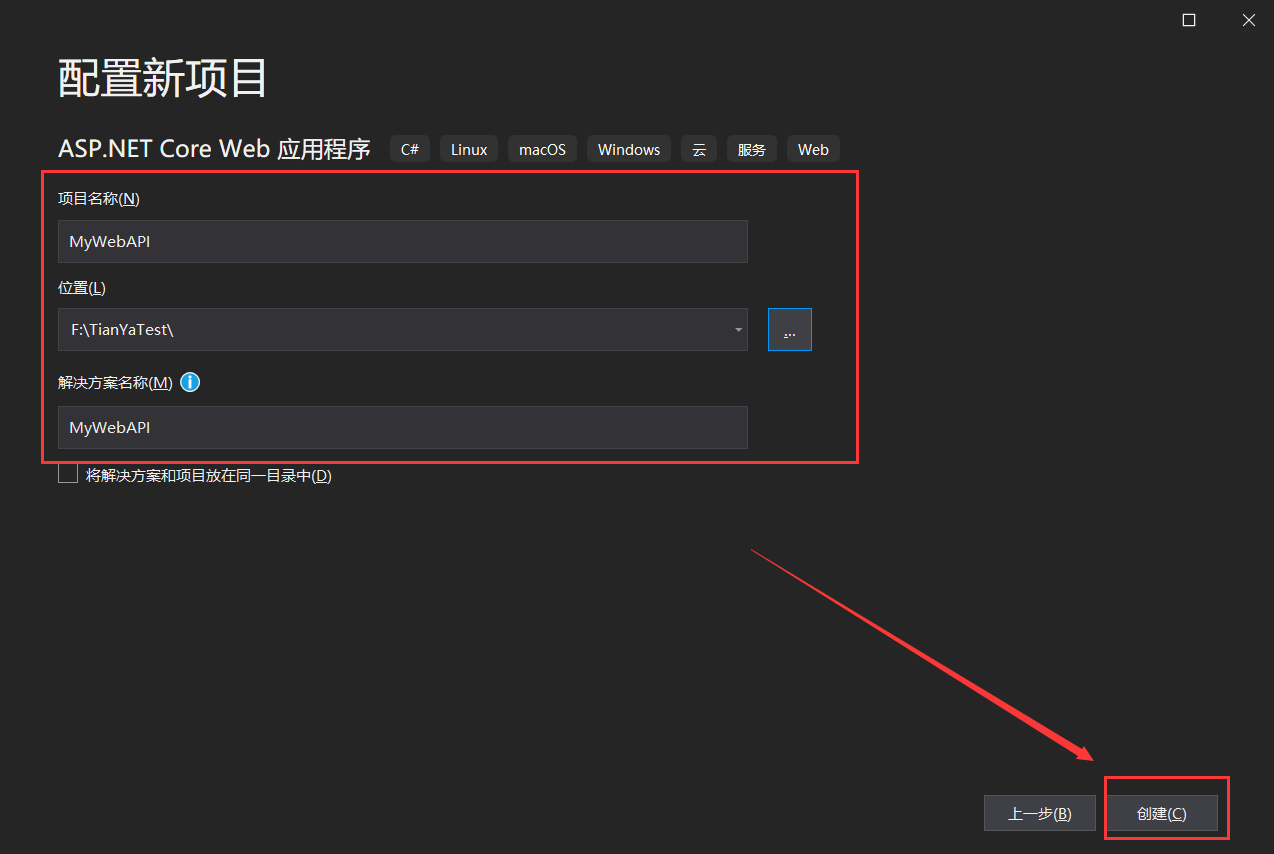
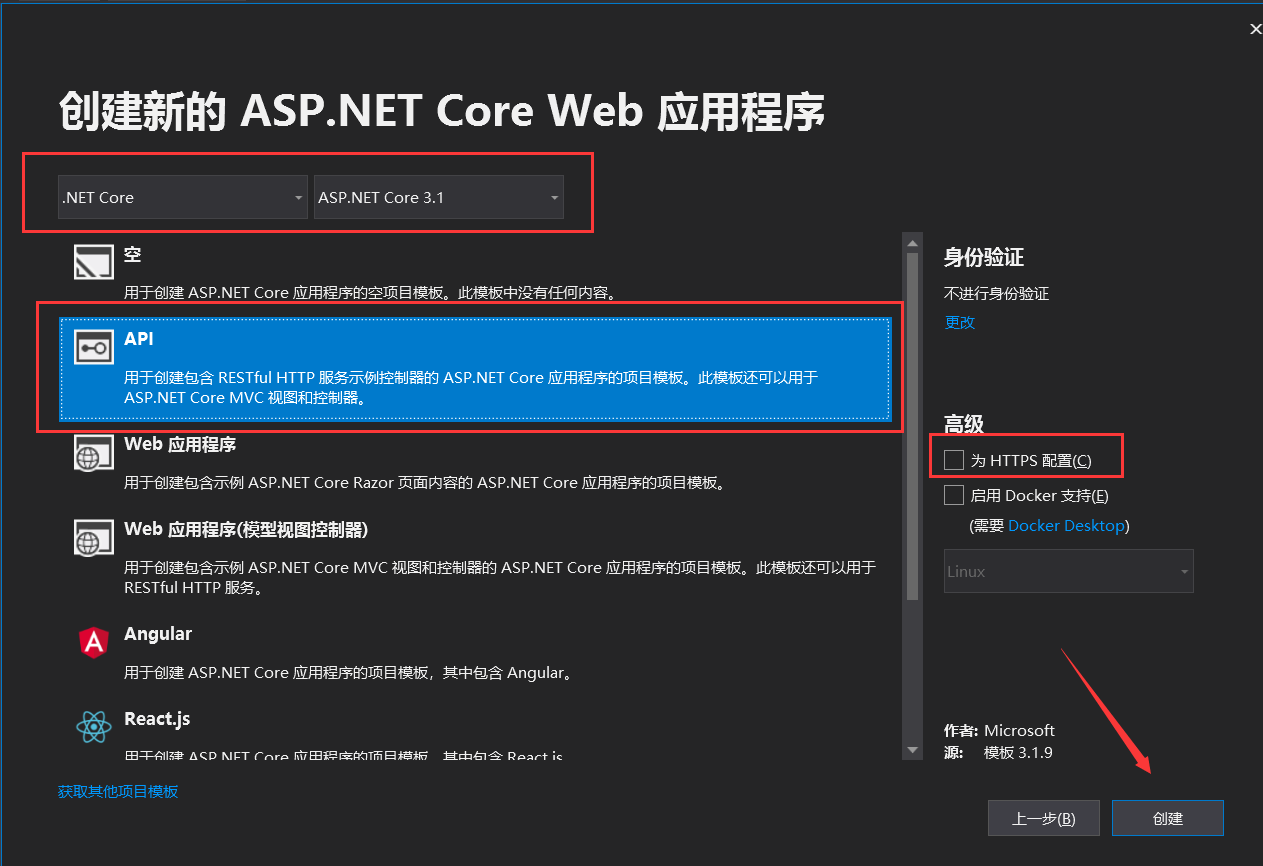
创建成功后如下所示:
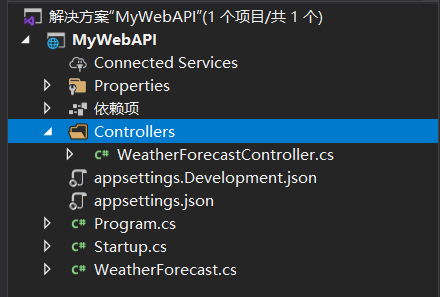
接下来我们添加一个名为Users的API控制器:
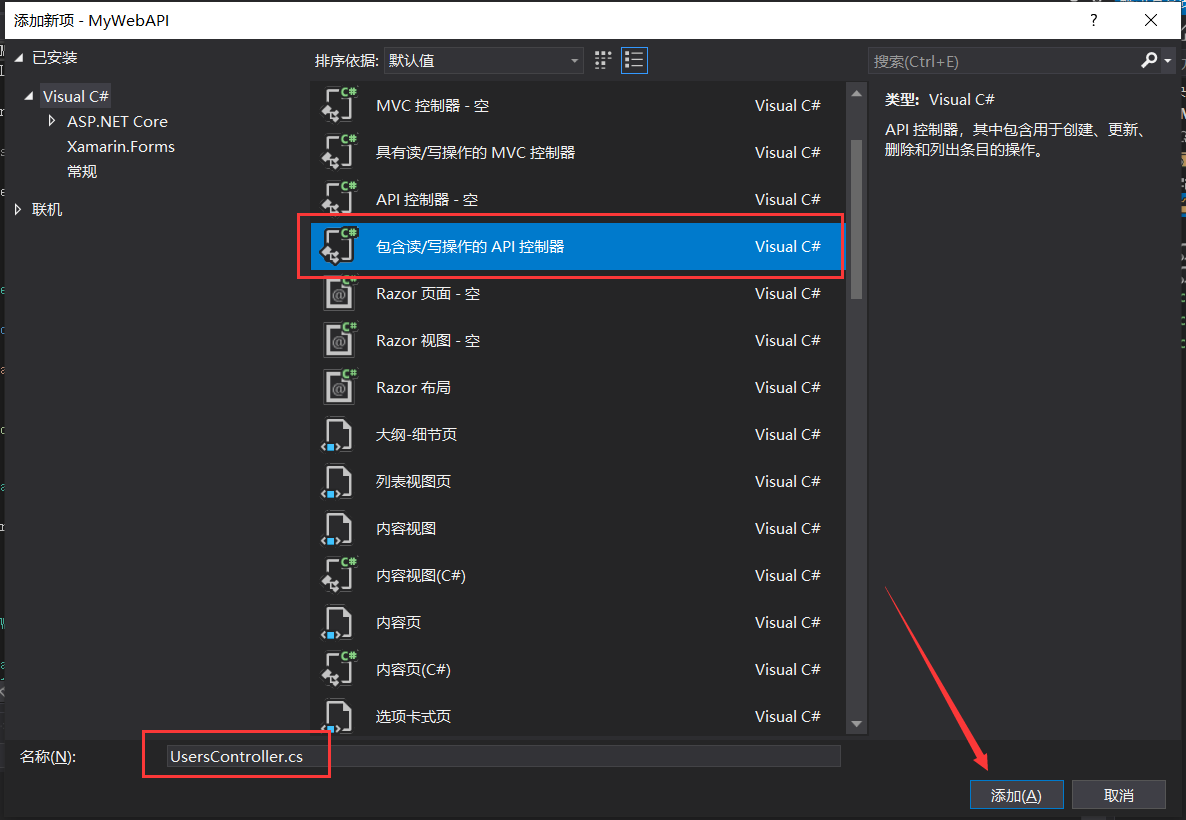
添加完成后我们来看下API控制器的结构:
using Microsoft.AspNetCore.Mvc;using System;using System.Collections.Generic;using System.Linq;using System.Threading.Tasks;// For more information on enabling Web API for empty projects, visit https://go.microsoft.com/fwlink/?LinkID=397860namespace MyWebAPI.Controllers{ [Route("api/[controller]")] [ApiController] public class UsersController : ControllerBase { // GET: api/<UsersController> [HttpGet] public IEnumerable<string> Get() { return new string[] { "value1", "value2" }; } // GET api/<UsersController>/5 [HttpGet("{id}")] public string Get(int id) { return "value"; } // POST api/<UsersController> [HttpPost] public void Post([FromBody] string value) { } // PUT api/<UsersController>/5 [HttpPut("{id}")] public void Put(int id, [FromBody] string value) { } // DELETE api/<UsersController>/5 [HttpDelete("{id}")] public void Delete(int id) { } }}可以看出API控制器继承了ControllerBase基类,标记了 [ApiController] Api控制器特性和 [Route("api/[controller]")] 路由特性,
以及不同类型的Action方法也分别标记了不同的特性,分别为:HttpGet、HttpPost、HttpPut、HttpDelete特性,这四个特性分别对应着查、增、改、删四个HTTP Method方法。
2、Web API路由
Web API路由规则如下:
1、请求进来时,会经过路由匹配找到合适的控制器。
2、那怎么找Action呢?
1)根据HttpMethod找方法,用方法名字开头(即使用Post、Delete、Put、Get这四个开头),Get开头就是对应Get请求。(该点在.NET Framework框架中适用)
2)如果不是使用Post、Delete、Put、Get这四个开头,也可以使用HttpGet、HttpPost、HttpPut、HttpDelete这四大特性。
3)按照参数找最吻合
4)在.NET Core路由中会优先匹配标记了HttpGet、HttpPost、HttpPut、HttpDelete这四大特性的Action,在没有匹配到的情况下才会去匹配别的Action,而且该Action可以不使用Post、Delete、Put、Get这四个开头。
熟悉MVC的人一开始可能会对这个规则很不习惯,在MVC中我们是通过控制器和Action定位到具体操作的。但是为什么在Web API中却不是这样的?
这是因为我们的Web API是严格遵循RESTful风格的,在RESTful风格中只有资源(万物皆资源)和增删改查操作,这里的资源可以把它看成我们的控制器,
那有了资源之后我们还需要去传递具体的方法或者说Action吗?不需要,这是因为我们的RESTful风格在设计的时候就已经将我们的增删改查操作对应到具体的HttpMethod方法(即Post、Delete、Put、Get这四大类型)。
下面我们通过具体的例子来看下Web API的路由规则:
using Microsoft.AspNetCore.Mvc;using System;using System.Collections.Generic;using System.Linq;using System.Threading.Tasks;// For more information on enabling Web API for empty projects, visit https://go.microsoft.com/fwlink/?LinkID=397860namespace MyWebAPI.Controllers{ [Route("api/[controller]")] [ApiController] public class ValuesController : ControllerBase { [HttpGet("{id:int}/Type/{typeId:int=666}")] //访问路径::5000/api/values/1/type/666 //[HttpGet("Get")] //访问路径::5000/api/values/get?id=1&typeId=666 //[Route("/api/[controller]/{id:int}/Type/{typeId:int}")] //访问路径::5000/api/values/1/type/666 (不推荐) public string Get(int id, int typeId) { return $"value-Type {id} {typeId}"; } //[HttpGet("{name}")] [Route("api/[controller]/{name}")] //路由模板不以"/"或"~/"开头则Action特性路由会和控制器特性路由叠加(合并) //访问路径::5000/api/values/api/values/abc public string OverlyingGet(string name) { return $"OverlyingGet {name}"; } //同是HttpGet请求时别的Action没有标记HttpGet情况下则会匹配该Action public IEnumerable<string> Test() { return new string[] { "Test1", "Test2" }; } // GET: api/<ValuesController> [HttpGet] //同是HttpGet请求时优先匹配带有HttpGet特性的 public IEnumerable<string> Get() { return new string[] { "value1", "value2" }; } // GET api/<ValuesController>/5 [HttpGet("{id:int?}")] public string Get(int id) { return $"value-{id}"; } // POST api/<ValuesController> [HttpPost] public void Post([FromBody] string value) { } // PUT api/<ValuesController>/5 [HttpPut("{id}")] public void Put(int id, [FromBody] string value) { } // DELETE api/<ValuesController>/5 [HttpDelete("{id}")] public void Delete(int id) { } }}PS:路由模板不以"/"或"~/"开头则Action特性路由会和控制器特性路由叠加(合并)。
使用.NET Core CLI来启动下项目:
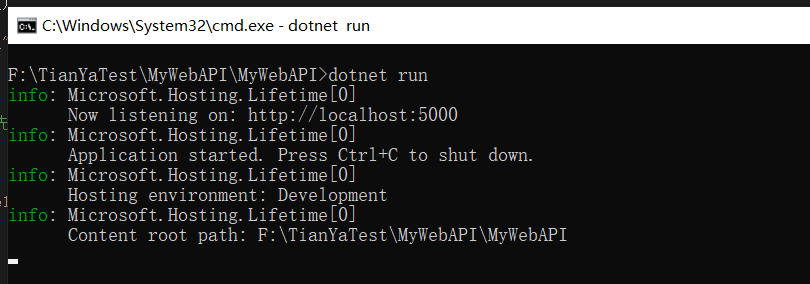
可以看出项目启动成功了,接下来我们使用浏览器来模拟HttpGet请求:
首先我们来看下采用MVC传统路由的方式访问有什么效果:
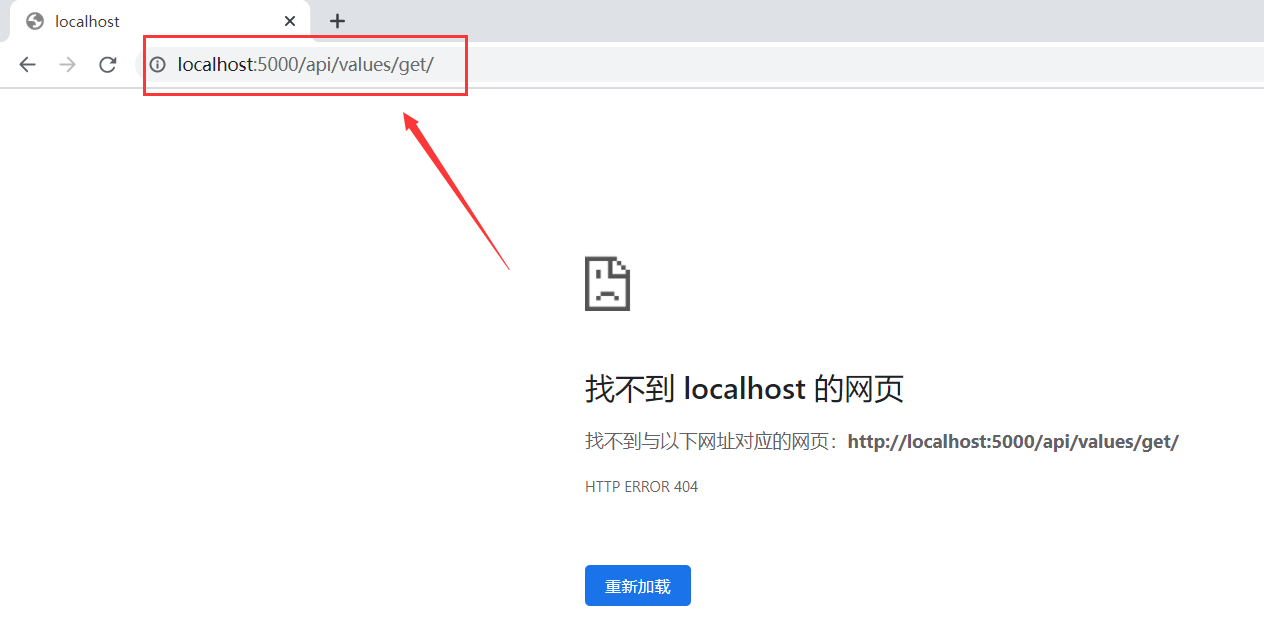
可以看到访问失败了,这是因为默认情况下WebApi的路由规则是RESTful风格的,接下来我们来看下正确的访问方式:





至此,我们已经给大家show完一波RESTful风格的路由规则了,那有人可能会问能不能改成传统的MVC路由规则呢?接下来我们就来演示一下:
首先要将控制器上面的[Route("api/[controller]")]和[ApiController]特性注释掉(PS:一旦标记了[ApiController]特性就必须要标记[Route("...")]特性)

然后修改Startup.cs文件,增加全局路由模板:
public void Configure(IApplicationBuilder app, IWebHostEnvironment env){ if (env.IsDevelopment()) { app.UseDeveloperExceptionPage(); } app.UseRouting(); app.UseAuthorization(); app.UseEndpoints(endpoints => { //endpoints.MapControllers(); //框架默认生成的 endpoints.MapControllerRoute( name: "defaultWithAreas", pattern: "api/{area:exists}/{controller=Home}/{action=Index}/{id?}"); endpoints.MapControllerRoute( name: "default", pattern: "api/{controller=Home}/{action=Index}/{id?}"); });}最后重新通过浏览器来访问下:


全局路由和特性路由可以共存,优先匹配特性路由:

可以看出,此时采用传统路由规则访问就能够成功了。
更多关于.NET Core路由的参考资料,如下:
微软官网关于ASP.NET Core 中的路由(包括路由约束):https://docs.microsoft.com/zh-cn/aspnet/core/fundamentals/routing?view=aspnetcore-3.1
特性路由合并:https://blog.csdn.net/sinolover/article/details/104329265/
Web API路由:https://blog.csdn.net/qq_34759481/article/details/85018684
关于路由的就介绍到这里了。
3、使用ajax请求Web API(PS:此处没有使用RESTful风格,而是采用传统的路由风格。)
为了演示我们额外建了一个MVC的项目,首先我们来看下MVC的前端代码部分:
@{ ViewData["Title"] = "Home Index"; Layout = null;}<div class="text-center"> <form id="frmUser"> <p> 用户Id:<input type="text" id="txtId" name="UserID" /> </p> <p> <input type="button" id="btnGet1" value="Get1" /> </p> <p> <input type="button" id="btnPost1" value="Post1" /> </p> <p> <input type="button" id="btnPut1" value="Put1" /> </p> <p> <input type="button" id="btnDelete1" value="Delete1" /> </p> </form> <script src="~/lib/jquery/dist/jquery.min.js"></script> <script> var user = { UserID: "10002", UserName: "TianYa", UserEmail: "12306@qq.com" }; var dirName = ""; $("#btnGet1").on("click", function () { $.ajax({ url: dirName + "/api/users/GetUserByID", type: "get", data: $("#frmUser").serialize(), success: function (data) { console.log(data); }, datatype: "json" }); }); $("#btnPost1").on("click", function () { $.ajax({ url: dirName + "/api/users/PostUser", type: "post", data: user, success: function (data) { console.log(data); }, datatype: "json" }); }); $("#btnPut1").on("click", function () { $.ajax({ url: dirName + "/api/users/PutUser", type: "put", data: $("#frmUser").serialize(), success: function (data) { console.log(data); }, datatype: "json" }); }); $("#btnDelete1").on("click", function () { $.ajax({ url: dirName + "/api/users/DeleteUser", type: "delete", data: { "userID": $("#txtId").val() }, success: function (data) { console.log(data); }, datatype: "json" }); }); </script></div>接着我们来看下Web API的相关代码:
using Microsoft.AspNetCore.Mvc;using System;using System.Collections.Generic;using System.Linq;using TianYa.Interface;using TianYa.Model;namespace MyWebAPI.Controllers{ //[Route("api/[controller]")] //[ApiController] public class UsersController : ControllerBase { private readonly IUserService _userService; public UsersController(IUserService userService) { _userService = userService; } [HttpGet] public Users GetUserByID(int userID) { return _userService.GetModel(userID); } [HttpPost] public Users PostUser(Users user) { return _userService.GetModel(user.UserID); } [HttpPut] public Users PutUser(Users user) { return _userService.GetModel(user.UserID); } [HttpDelete] public Users DeleteUser(int userID) { return _userService.GetModel(userID); } }}using System;using System.Collections.Generic;using System.Text;namespace TianYa.Model{ /// <summary> /// 用户 /// </summary> public class Users { public int UserID { get; set; } public string UserName { get; set; } public string UserEmail { get; set; } }}using System;using System.Collections.Generic;using System.Linq;using TianYa.Model;using TianYa.Interface;namespace TianYa.Service{ /// <summary> /// 用户服务层 /// </summary> public class UserService : IUserService { private List<Users> _listUsers = new List<Users>(); public UserService() { _listUsers.Add(new Users { UserID = 10000, UserName = "张三", UserEmail = "zhangsan@qq.com" }); _listUsers.Add(new Users { UserID = 10001, UserName = "李四", UserEmail = "lisi@qq.com" }); _listUsers.Add(new Users { UserID = 10002, UserName = "王五", UserEmail = "wangwu@qq.com" }); _listUsers.Add(new Users { UserID = 10003, UserName = "赵六", UserEmail = "zhaoliu@qq.com" }); } public Users GetModel(int userId) { return _listUsers.FirstOrDefault(m => m.UserID == userId) ?? _listUsers[0]; } }}然后使用.NET Core CLI来分别启动MVC项目和Web API项目,启动成功后我们来访问下:
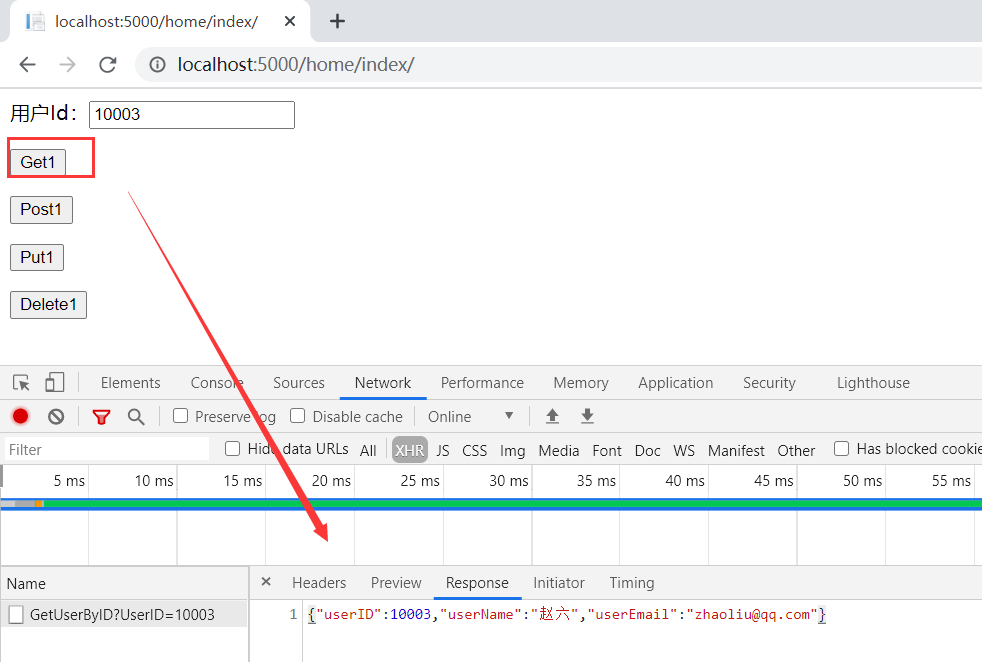
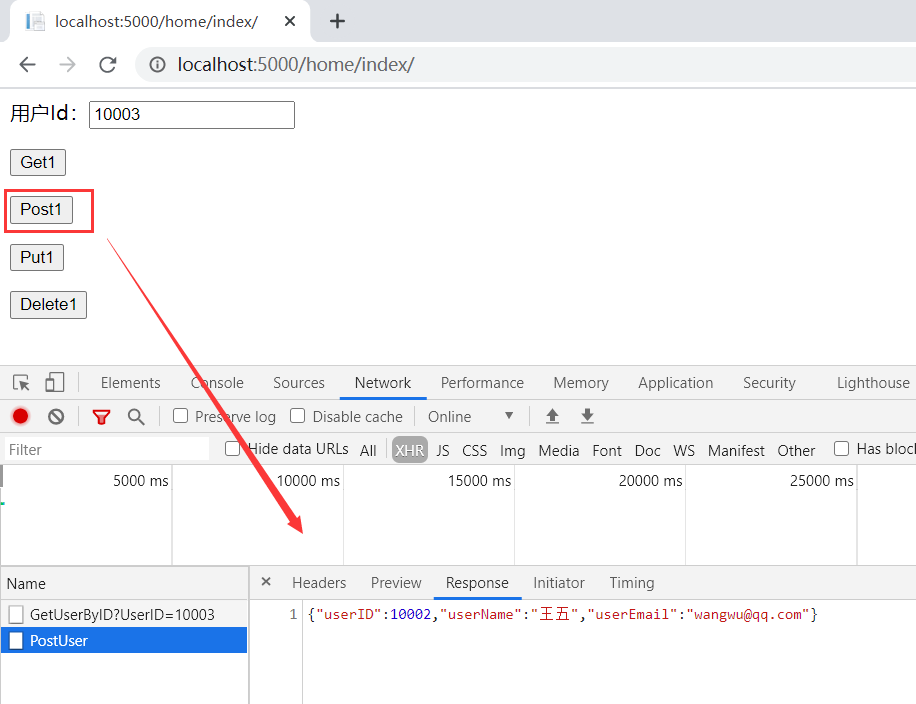
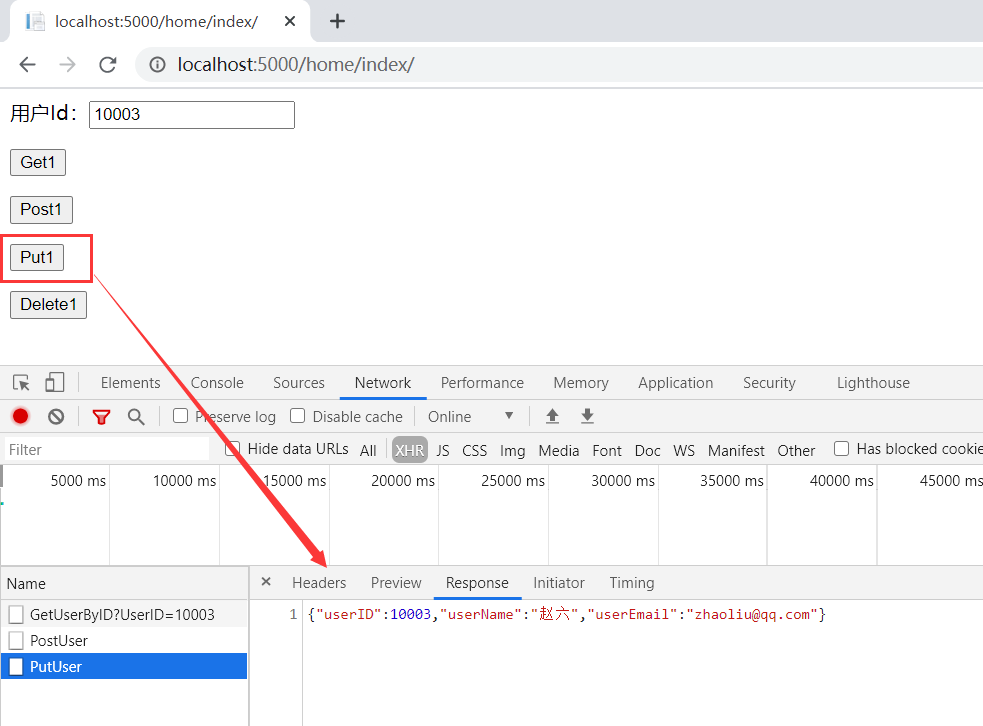
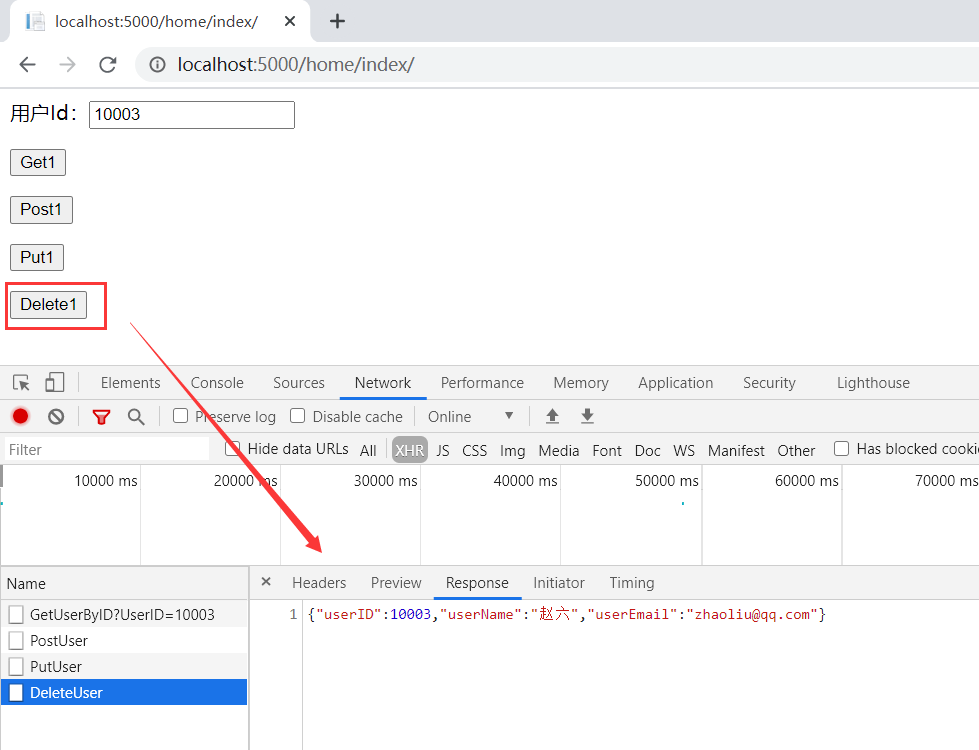
从运行结果中可以发现:
1、在Web API的Action方法中返回的是Users类型,但是响应到前端的时候Web API会帮我们自动转换成指定的类型(例如:Json或
2、响应到前端的Json数据的格式默认采用的是驼峰命名法。
那怎么才能使响应到前端的Json数据保留原来的格式呢?
首先需要先引用 Microsoft.AspNetCore.Mvc.NewtonsoftJson 包:
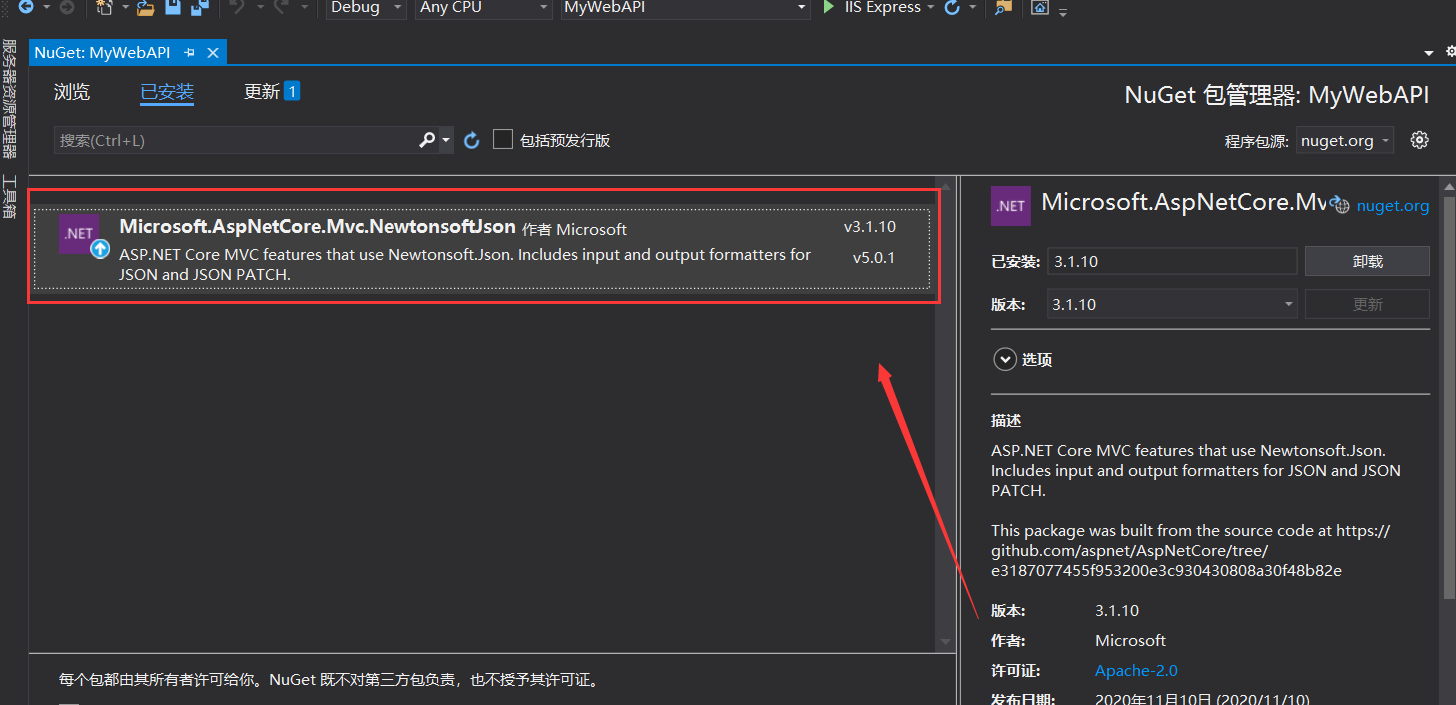
然后修改Startup.cs文件,如下所示:
using Microsoft.AspNetCore.Builder;using Microsoft.AspNetCore.Hosting;using Microsoft.AspNetCore.Mvc;using Microsoft.Extensions.Configuration;using Microsoft.Extensions.DependencyInjection;using Microsoft.Extensions.Hosting;using Newtonsoft.Json;using Newtonsoft.Json.Serialization;using System;using System.Collections.Generic;using System.Linq;using TianYa.Interface;using TianYa.Service;namespace MyWebAPI{ public class Startup { private readonly string _myCorsPolicy = "MyCorsPolicy"; public Startup(IConfiguration configuration) { Configuration = configuration; } public IConfiguration Configuration { get; } // This method gets called by the runtime. Use this method to add services to the container. public void ConfigureServices(IServiceCollection services) { services.AddControllers().AddNewtonsoftJson(options => { // 忽略循环引用 options.SerializerSettings.ReferenceLoopHandling = ReferenceLoopHandling.Ignore; // 不使用驼峰 options.SerializerSettings.ContractResolver = new DefaultContractResolver(); // 设置时间格式 options.SerializerSettings.DateFormatString = "yyyy-MM-dd HH:mm:ss"; // 如字段为null值,该字段不会返回到前端 // options.SerializerSettings.NullValueHandling = NullValueHandling.Ignore; }); services.AddCors(options => //设置跨域策略 options.AddPolicy(_myCorsPolicy, builder => { builder .AllowAnyOrigin() .AllowAnyMethod() .AllowAnyHeader(); }) ); services.AddTransient<IUserService, UserService>(); //依赖注入 } // This method gets called by the runtime. Use this method to configure the HTTP request pipeline. public void Configure(IApplicationBuilder app, IWebHostEnvironment env) { if (env.IsDevelopment()) { app.UseDeveloperExceptionPage(); } app.UseRouting(); app.UseAuthorization(); app.UseCors(_myCorsPolicy); app.UseEndpoints(endpoints => { //endpoints.MapControllers(); //框架默认生成的 endpoints.MapControllerRoute( name: "defaultWithAreas", pattern: "api/{area:exists}/{controller=Home}/{action=Index}/{id?}"); endpoints.MapControllerRoute( name: "default", pattern: "api/{controller=Home}/{action=Index}/{id?}"); }); } }}设置完成重新启动成功后,我们再来访问下:
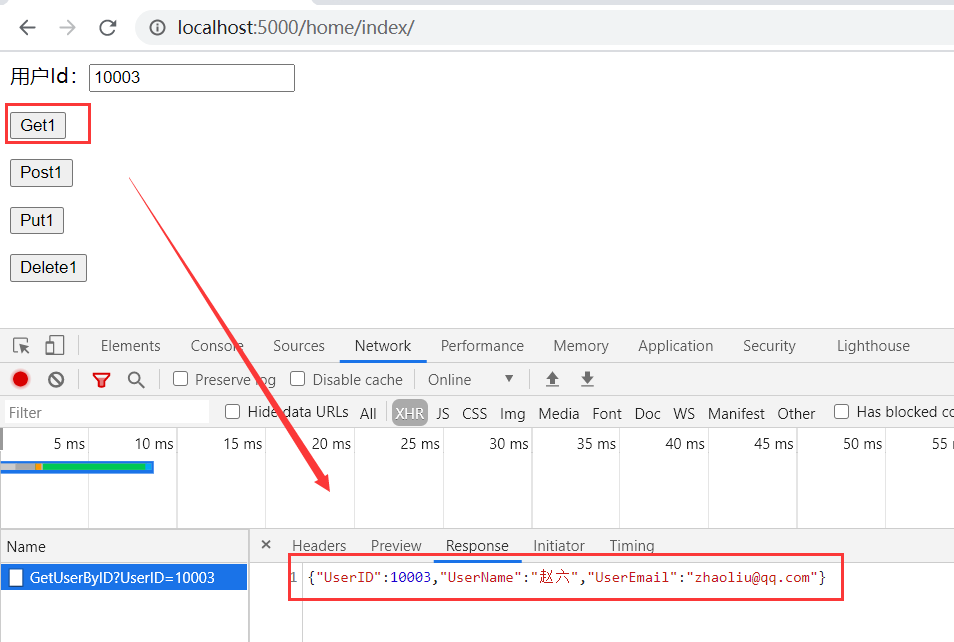
从运行结果可以看出此时返回到前端的Json数据保留了原来的格式。
至此本文就全部介绍完了,如果觉得对您有所启发请记得点个赞哦!!!
此文由博主精心撰写转载请保留此原文链接:https://www.cnblogs.com/xyh9039/p/14163991.html
版权声明:如有雷同纯属巧合,如有侵权请及时联系本人修改,谢谢!!!
原文转载:http://www.shaoqun.com/a/504277.html
焦点科技:https://www.ikjzd.com/w/1831
淘粉8:https://www.ikjzd.com/w/1725.html
本章将和大家分享ASP.NETCore中的WebAPI。本章将和大家分享ASP.NETCore中的WebAPI。一、RESTful架构风格REST(RepresentationalStateTransfer)表现层的状态转化,是一个接口的设计风格。是Web服务的一种新的架构风格(一种思想)。资源:万物看成资源。使用POST,DELETE,PUT和GET四种请求方式分别对指定的URL资源进行增删改查
Zozo:Zozo
凹凸曼:凹凸曼
无锡有哪些好吃的特产?:无锡有哪些好吃的特产?
家居花园、手机配件类趋势纷纷开始下降,户外玩具成"真香"品类:家居花园、手机配件类趋势纷纷开始下降,户外玩具成"真香"品类
桂林火车站到阳朔有多远?怎么走最方便?:桂林火车站到阳朔有多远?怎么走最方便?
No comments:
Post a Comment